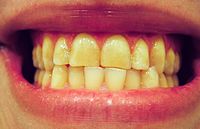
Photo from wikipedia
BACKGROUND The causal relationship between bruxism and temporomandibular disorders (TMD) is not clear. OBJECTIVES The present study investigated which TMD are associated with probable sleep bruxism (SB) and awake bruxism… Click to show full abstract
BACKGROUND The causal relationship between bruxism and temporomandibular disorders (TMD) is not clear. OBJECTIVES The present study investigated which TMD are associated with probable sleep bruxism (SB) and awake bruxism (AB) according to the Diagnostic Criteria for Temporomandibular Disorders (DC/TMD). The study further evaluated the association between probable SB and AB and TMD. MATERIAL AND METHODS A total of 143 patients were selected - bruxers (SB and AB) and non-bruxers. A diagnosis of probable bruxism was made after a physical examination and when the symptoms were detected. The patients were evaluated using DC/TMD. From among Axis I assessment instruments, the TMD Pain Screener, the Symptom Questionnaire and the Clinical Examination Form were used. Moreover, the Graded Chronic Pain Scale (GCPS) (v. 2), the Jaw Functional Limitation Scale-8 (JFLS-8), the Patient Health Questionnaire-4 (PHQ-4), and the Oral Behaviors Checklist (OBC) were applied within the scope of Axis II. RESULTS Diagnoses of muscle disorders and disk displacement with reduction were significantly more frequent in the SB and AB groups than in non-bruxers. A diagnosis of arthralgia was significantly more prevalent in the AB group than in non-bruxers. The JFLS-8 scores and the TMD Pain Screener scores were higher in the AB group than in the SB group and in non-bruxers. Distress levels, and the GCPS and OBC scores were higher in the SB and AB groups as compared to non-bruxers. The results of binary logistic regression analysis showed that only the OBC score was significantly higher in the TMD subgroup (OR (odds ratio) = 1.228; 95% CI (confidence interval): 1.014-1.488). CONCLUSIONS Both SB and AB were associated with pain-related TMD and intra-articular joint disorders. The muscle disorders and disk displacement with reduction subtypes were associated with SB and AB. Unlike SB, AB was also associated with arthralgia. Bruxers (both SB and AB) displayed parafunctional habits. However, AB was associated with greater functional limitation of the jaw as compared to SB.
Journal Title: Dental and medical problems
Year Published: 2023
Link to full text (if available)
Share on Social Media: Sign Up to like & get
recommendations!